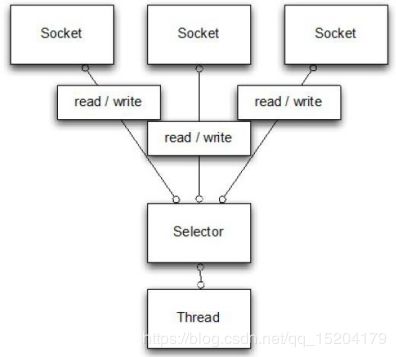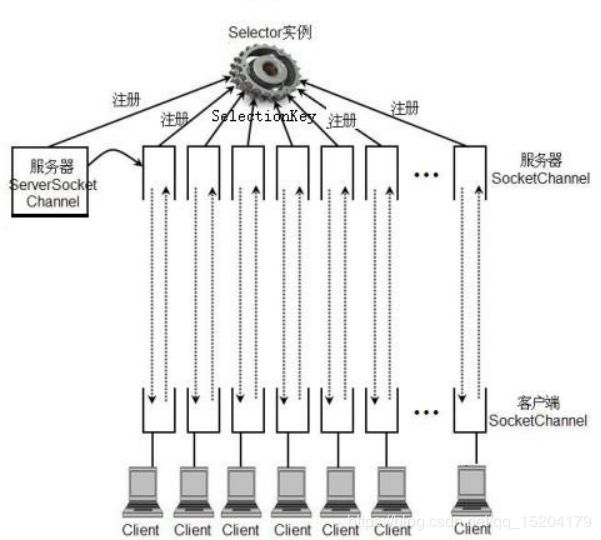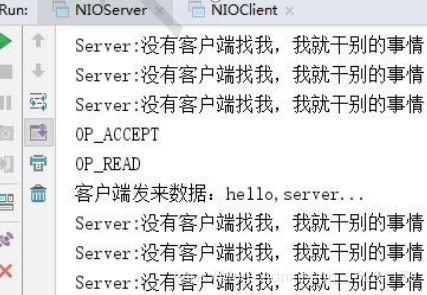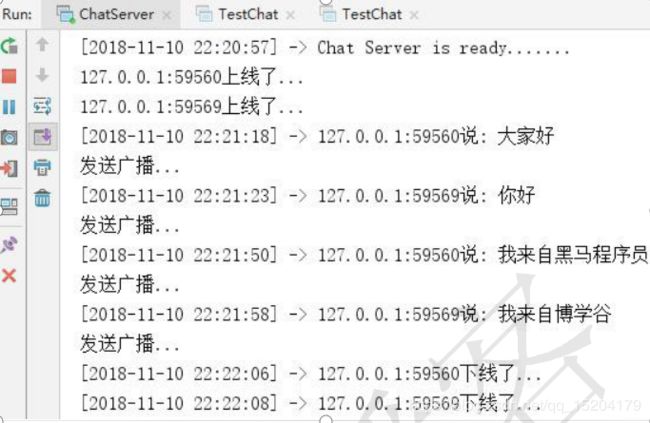BIO,Socket网络编程入门代码示例,NIO网络编程入门代码示例,AIO 网络编程
BIO,Socket网络编程入门代码示例
1.BIO服务器端程序
package cn.itcast.bio;
import java.io.InputStream;
import java.io.OutputStream;
import java.net.ServerSocket;
import java.net.Socket;
//BIO 服务器端程序
public class TCPServer {
public static void main(String[] args) throws Exception {
//1.创建ServerSocket对象
ServerSocket ss=new ServerSocket(9999); //端口号
while (true) {
//2.监听客户端
System.out.println("来呀");
Socket s = ss.accept(); //阻塞
System.out.println("来呀");
//3.从连接中取出输入流来接收消息
InputStream is = s.getInputStream(); //阻塞
byte[] b = new byte[10];
is.read(b);
String clientIP = s.getInetAddress().getHostAddress();
System.out.println(clientIP + "说:" + new String(b).trim());
//4.从连接中取出输出流并回话
//OutputStream os = s.getOutputStream();
//os.write("没钱".getBytes());
//5.关闭
//s.close();
}
}
}
2.BIO 客户端程序
package cn.itcast.bio;
import java.io.InputStream;
import java.io.OutputStream;
import java.net.Socket;
import java.util.Scanner;
//BIO 客户端程序
public class TCPClient {
public static void main(String[] args) throws Exception {
while (true) {
//1.创建Socket对象
Socket s = new Socket("127.0.0.1", 9999);
//2.从连接中取出输出流并发消息
OutputStream os = s.getOutputStream();
System.out.println("请输入:");
Scanner sc = new Scanner(System.in);
String msg = sc.nextLine();
os.write(msg.getBytes());
//3.从连接中取出输入流并接收回话
InputStream is = s.getInputStream(); //阻塞
byte[] b = new byte[20];
is.read(b);
System.out.println("老板说:" + new String(b).trim());
//4.关闭
s.close();
}
}
}
NIO网络编程入门代码示例
1.操作文件
package cn.itcast.nio.file;
import org.junit.Test;
import java.io.File;
import java.io.FileInputStream;
import java.io.FileOutputStream;
import java.nio.ByteBuffer;
import java.nio.channels.FileChannel;
//通过NIO实现文件IO
public class TestNIO {
@Test //往本地文件中写数据
public void test1() throws Exception{
//1. 创建输出流
FileOutputStream fos=new FileOutputStream("basic.txt");
//2. 从流中得到一个通道
FileChannel fc=fos.getChannel();
//3. 提供一个缓冲区
ByteBuffer buffer=ByteBuffer.allocate(1024);
//4. 往缓冲区中存入数据
String str="hello,nio";
buffer.put(str.getBytes());
//5. 翻转缓冲区
buffer.flip();
//6. 把缓冲区写到通道中
fc.write(buffer);
//7. 关闭
fos.close();
}
@Test //从本地文件中读取数据
public void test2() throws Exception{
File file=new File("basic.txt");
//1. 创建输入流
FileInputStream fis=new FileInputStream(file);
//2. 得到一个通道
FileChannel fc=fis.getChannel();
//3. 准备一个缓冲区
ByteBuffer buffer=ByteBuffer.allocate((int)file.length());
//4. 从通道里读取数据并存到缓冲区中
fc.read(buffer);
System.out.println(new String(buffer.array()));
//5. 关闭
fis.close();
}
@Test //使用NIO实现文件复制
public void test3() throws Exception{
//1. 创建两个流
FileInputStream fis=new FileInputStream("basic.txt");
FileOutputStream fos=new FileOutputStream("c:\\test\\basic.txt");
//2. 得到两个通道
FileChannel sourceFC=fis.getChannel();
FileChannel destFC=fos.getChannel();
//3. 复制
destFC.transferFrom(sourceFC,0,sourceFC.size());
//4. 关闭
fis.close();
fos.close();
}
}
NIO
网络 IO
概述和核心 API
前面在进行文件 IO 时用到的 FileChannel 并不支持非阻塞操作,学习 NIO 主要就是进行网络 IO,Java NIO 中的网络通道是非阻塞 IO 的实现,基于事件驱动,非常适用于服务器需要维持大量连接,但是数据交换量不大的情况,例如一些即时通信的服务等等....
在 Java 中编写 Socket 服务器,通常有以下几种模式:
- 一个客户端连接用一个线程,优点:程序编写简单;缺点:如果连接非常多,分配的线 程也会非常多,服务器可能会因为资源耗尽而崩溃。
- 把每一个客户端连接交给一个拥有固定数量线程的连接池,优点:程序编写相对简单, 可以处理大量的连接。确定:线程的开销非常大,连接如果非常多,排队现象会比较严重。
-
使用 Java 的 NIO,用非阻塞的 IO 方式处理。这种模式可以用一个线程,处理大量的客户端连接。
1.Selector(选择器),能够检测多个注册的通道上是否有事件发生,如果有事件发生,便获取事件然后针对每个事件进行相应的处理。这样就可以只用一个单线程去管理多个通道,也就是管理多个连接。这样使得只有在连接真正有读写事件发生时,才会调用函数来进行读写, 就大大地减少了系统开销,并且不必为每个连接都创建一个线程,不用去维护多个线程,并且避免了多线程之间的上下文切换导致的开销。
该类的常用方法如下所示:
- public static Selector open(),得到一个选择器对象
- public int select(long timeout),监控所有注册的通道,当其中有 IO 操作可以进行时,将对应的 SelectionKey 加入到内部集合中并返回,参数用来设置超时时间
- public Set
selectedKeys(),从内部集合中得到所有的 SelectionKey - SelectionKey,代表了 Selector 和网络通道的注册关系,一共四种:
- int OP_ACCEPT:有新的网络连接可以 accept,值为 16
- int OP_CONNECT:代表连接已经建立,值为 8
- int OP_READ 和 int OP_WRITE:代表了读、写操作,值为 1 和 4
- 该类的常用方法如下所示:
- public abstract Selector selector(),得到与之关联的 Selector 对象
- public abstract SelectableChannel channel(),得到与之关联的通道
- public final Object attachment(),得到与之关联的共享数据
- public abstract SelectionKey interestOps(int ops),设置或改变监听事件
- public final boolean isAcceptable(),是否可以 accept
- public final boolean isReadable(),是否可以读
- public final boolean isWritable(),是否可以写
1.ServerSocketChannel,用来在服务器端监听新的客户端 Socket 连接,常用方法如下所示:
- public static ServerSocketChannel open(),得到一个 ServerSocketChannel 通道
- public final ServerSocketChannel bind(SocketAddress local),设置服务器端端口号
- public final SelectableChannel configureBlocking(boolean block),设置阻塞或非阻塞模式, 取值 false 表示采用非阻塞模式
- public SocketChannel accept(),接受一个连接,返回代表这个连接的通道对象
- public final SelectionKey register(Selector sel, int ops),注册一个选择器并设置监听事件
4.SocketChannel,网络 IO 通道,具体负责进行读写操作。NIO 总是把缓冲区的数据写入通道,或者把通道里的数据读到缓冲区。常用方法如下所示:
- public static SocketChannel open(),得到一个 SocketChannel 通道
- public final SelectableChannel configureBlocking(boolean block),设置阻塞或非阻塞模式, 取值 false 表示采用非阻塞模式
- public boolean connect(SocketAddress remote),连接服务器
- public boolean finishConnect(),如果上面的方法连接失败,接下来就要通过该方法完成连接操作
- public int write(ByteBuffer src),往通道里写数据
- public int read(ByteBuffer dst),从通道里读数据
- public final SelectionKey register(Selector sel, int ops, Object att),注册一个选择器并设置监听事件,最后一个参数可以设置共享数据
- public final void close(),关闭通道
入门案例
API 学习完毕后,接下来我们使用 NIO 开发一个入门案例,实现服务器端和客户端之间的数据通信(非阻塞)。
//网络服务器端程序public class NIOServer {
public static void main(String[] args) throws Exception{
//1. 得到一个 ServerSocketChannel 对象 老大
ServerSocketChannel serverSocketChannel=ServerSocketChannel.open();
//2. 得到一个 Selector 对象 间谍
Selector selector=Selector.open();
//3. 绑定一个端口号
serverSocketChannel.bind(new InetSocketAddress(9999));
//4. 设置非阻塞方式
serverSocketChannel.configureBlocking(false);
//5. 把 ServerSocketChannel 对象注册给 Selector 对象
serverSocketChannel.register(selector, SelectionKey.OP_ACCEPT);
//6. 干活
while(true){
//6.1 监控客户端
if(selector.select(2000)==0){ //nio 非阻塞式的优势
System.out.println("Server:没有客户端搭理我,我就干点别的事"); continue;
}
//6.2 得到 SelectionKey,判断通道里的事件Iterator keyIterator=selector.selectedKeys().iterator(); while(keyIterator.hasNext()){
SelectionKey key=keyIterator.next(); if(key.isAcceptable()){ //客户端连接请求事件
System.out.println("OP_ACCEPT");
SocketChannel socketChannel=serverSocketChannel.accept(); socketChannel.configureBlocking(false); socketChannel.register(selector,SelectionKey.OP_READ, ByteBuffer.allocate(1024));
}
if(key.isReadable()){ //读取客户端数据事件SocketChannel channel=(SocketChannel) key.channel(); ByteBuffer buffer=(ByteBuffer) key.attachment(); channel.read(buffer);
System.out.println("客户端发来数据:"+new String(buffer.array()));
}
// 6.3 手动从集合中移除当前 key,防止重复处理
keyIterator.remove();
}
}
}
} 上面代码用 NIO 实现了一个服务器端程序,能不断接受客户端连接并读取客户端发过来的数据。
//网络客户端程序public class NIOClient {
public static void main(String[] args) throws Exception{
//1. 得到一个网络通道
SocketChannel channel=SocketChannel.open();
//2. 设置非阻塞方式
channel.configureBlocking(false);
//3. 提供服务器端的 IP 地址和端口号
InetSocketAddress address=new InetSocketAddress("127.0.0.1",9999);
//4. 连接服务器端
if(!channel.connect(address)){
while(!channel.finishConnect()){ //nio 作为非阻塞式的优势
System.out.println("Client:连接服务器端的同时,我还可以干别的一些事情");
}
}
//5. 得到一个缓冲区并存入数据
String msg="hello,Server";
ByteBuffer writeBuf = ByteBuffer.wrap(msg.getBytes());
//6. 发送数据channel.write(writeBuf); System.in.read();
}上面代码通过 NIO 实现了一个客户端程序,连接上服务器端后发送了一条数据,运行效果如下图所示:
网络聊天案例:
刚才我们通过 NIO 实现了一个入门案例,基本了解了 NIO 的工作方式和运行流程,接下来我们用 NIO 实现一个多人聊天案例,具体代码如下所示:
public class ChatServer { private Selector selector;
private ServerSocketChannel listenerChannel; private static final int PORT = 9999; //服务器端口
public ChatServer() { try {
// 得到选择器
selector = Selector.open();
// 打开监听通道
listenerChannel = ServerSocketChannel.open();
// 绑定端口
listenerChannel.bind(new InetSocketAddress(PORT));
// 设置为非阻塞模式
listenerChannel.configureBlocking(false);
// 将选择器绑定到监听通道并监听 accept 事件listenerChannel.register(selector, SelectionKey.OP_ACCEPT); printInfo("Chat Server is ready.......");
} catch (IOException e) { e.printStackTrace();
}
}
public void start() { try {
while (true) { //不停轮询
int count = selector.select();//获取就绪 channel if (count > 0) {
Iterator iterator = selector.selectedKeys().iterator(); while (iterator.hasNext()) {
SelectionKey key = iterator.next();
// 监听到 accept
if (key.isAcceptable()) {
SocketChannel sc = listenerChannel.accept();
//非阻塞模式sc.configureBlocking(false);
// 注 册 到 选 择 器 上 并 监 听 read sc.register(selector, SelectionKey.OP_READ);
System.out.println(sc.getRemoteAddress().toString().substring(1)+"上线了...");
key.interestOps(SelectionKey.OP_ACCEPT);
}
//监听到 read
if (key.isReadable()) {
readMsg(key); //读取客户端发来的数据
}
} else {
}
//一定要把当前 key 删掉,防止重复处理
iterator.remove();
System.out.println("独自在寒风中等候...");
}
}
} catch (IOException e) { e.printStackTrace();
}
}
private void readMsg(SelectionKey key) { SocketChannel channel = null;
try {
// 得到关联的通道
channel = (SocketChannel) key.channel();
//设置 buffer 缓冲区
ByteBuffer buffer = ByteBuffer.allocate(1024);
//从通道中读取数据并存储到缓冲区中int count = channel.read(buffer);
//如果读取到了数据if (count > 0) {
//把缓冲区数据转换为字符串
String msg = new String(buffer.array()); printInfo(msg);
//将关联的 channel 设置为 read,继续准备接受数据key.interestOps(SelectionKey.OP_READ); BroadCast(channel, msg); //向所有客户端广播数据
}
buffer.clear();
} catch (IOException e) { try {
//当客户端关闭 channel 时,进行异常如理printInfo(channel.getRemoteAddress().toString().substring(1) + "下线了..."); key.cancel(); //取消注册
channel.close(); //关闭通道
} catch (IOException e1) {
e1.printStackTrace();
}
}
}
public void BroadCast(SocketChannel except, String msg) throws IOException { System.out.println("发送广播...");
//广播数据到所有的 SocketChannel 中
for (SelectionKey key : selector.keys()) { Channel targetchannel = key.channel();
//排除自身
if (targetchannel instanceof SocketChannel && targetchannel != except) { SocketChannel dest = (SocketChannel) targetchannel;
//把数据存储到缓冲区中
ByteBuffer buffer = ByteBuffer.wrap(msg.getBytes());
//往通道中写数据dest.write(buffer);
}
}
}
private void printInfo(String str) { //往控制台打印消息
SimpleDateFormat sdf = new SimpleDateFormat("yyyy-MM-dd HH:mm:ss"); System.out.println("[" + sdf.format(new Date()) + "] -> " + str);
}
public static void main(String[] args) { ChatServer server = new ChatServer(); server.start();
} 上述代码使用 NIO 编写了一个聊天程序的服务器端,可以接受客户端发来的数据,并能把
数据广播给所有客户端。
public class ChatClient {
private final String HOST = "127.0.0.1"; //服务器地址private int PORT = 9999; //服务器端口
private Selector selector;
private SocketChannel socketChannel; private String userName;
public ChatClient() throws IOException {
//得到选择器
selector = Selector.open();
//连接远程服务器
socketChannel = SocketChannel.open(new InetSocketAddress("127.0.0.1", PORT));
//设置非阻塞socketChannel.configureBlocking(false);
// 注 册 选 择 器 并 设 置 为 read socketChannel.register(selector, SelectionKey.OP_READ);
//得到客户端 IP 地址和端口信息,作为聊天用户名使用
userName = socketChannel.getLocalAddress().toString().substring(1); System.out.println("---------------Client(" + userName + ") is ready---------------");
}
//向服务器端发送数据
public void sendMsg(String msg) throws Exception {
//如果控制台输入 bye 就关闭通道,结束聊天
if (msg.equalsIgnoreCase("bye")) { socketChannel.close(); socketChannel = null;
return;
}
msg = userName + "说: " + msg; try {
//往通道中写数据socketChannel.write(ByteBuffer.wrap(msg.getBytes()));
} catch (IOException e) { e.printStackTrace();
}
}
//从服务器端接收数据public void receiveMsg() {
try {
int readyChannels = selector.select(); if (readyChannels > 0) { //有可用通道
Set selectedKeys = selector.selectedKeys(); Iterator keyIterator = selectedKeys.iterator(); while (keyIterator.hasNext()) {
SelectionKey sk = (SelectionKey) keyIterator.next(); if (sk.isReadable()) {
//得到关联的通道
SocketChannel sc = (SocketChannel) sk.channel();
//得到一个缓冲区
ByteBuffer buff = ByteBuffer.allocate(1024);
//读取数据并存储到缓冲区sc.read(buff);
//把缓冲区数据转换成字符串
String msg = new String(buff.array()); System.out.println(msg.trim());
}
keyIterator.remove(); //删除当前 SelectionKey,防止重复处理
}
} else {
System.out.println("人呢?都去哪儿了?没人聊天啊...");
}
} catch (IOException e) { e.printStackTrace();
}
}
}上述代码通过 NIO 编写了一个聊天程序的客户端,可以向服务器端发送数据,并能接收服
务器广播的数据。
public class TestChat {
public static void main(String[] args) throws Exception {
//创建一个聊天客户端对象
ChatClient chatClient = new ChatClient();
new Thread() { //单独开一个线程不断的接收服务器端广播的数据public void run() {
while (true) {
chatClient.receiveMsg(); try { //间隔 3 秒
Thread.currentThread().sleep(3000);
} catch (InterruptedException e) { e.printStackTrace();
}
}
}
}.start();
Scanner scanner = new Scanner(System.in);
//在控制台输入数据并发送到服务器端while (scanner.hasNextLine()) {
String msg = scanner.nextLine(); chatClient.sendMsg(msg);
}
}
}上述代码运行了聊天程序的客户端,并在主线程中发送数据,在另一个线程中不断接收服务 器端的广播数据,该代码运行一次就是一个聊天客户端,可以同时运行多个聊天客户端,聊 天效果如下图所示:
AIO 编程
JDK 7 引入了 Asynchronous I/O,即 AIO。在进行 I/O 编程中,常用到两种模式:Reactor 和 Proactor。Java 的 NIO 就是 Reactor,当有事件触发时,服务器端得到通知,进行相应的处理。
AIO 即 NIO2.0,叫做异步不阻塞的 IO。AIO 引入异步通道的概念,采用了 Proactor 模式, 简化了程序编写,一个有效的请求才启动一个线程,它的特点是先由操作系统完成后才通知服务端程序启动线程去处理,一般适用于连接数较多且连接时间较长的应用。
目前 AIO 还没有广泛应用,并且也不是本课程的重点内容,这里暂不做讲解。
IO 对比总结
IO 的方式通常分为几种:同步阻塞的 BIO、同步非阻塞的 NIO、异步非阻塞的 AIO。
- BIO 方式适用于连接数目比较小且固定的架构,这种方式对服务器资源要求比较高,并发局限于应用中,JDK1.4 以前的唯一选择,但程序直观简单易理解。
- NIO 方式适用于连接数目多且连接比较短(轻操作)的架构,比如聊天服务器,并发局限于应用中,编程比较复杂,JDK1.4 开始支持。
- AIO 方式使用于连接数目多且连接比较长(重操作)的架构,比如相册服务器,充分调用 OS 参与并发操作,编程比较复杂,JDK7 开始支持。
举个例子再理解一下:
- 同步阻塞:你到饭馆点餐,然后在那等着,啥都干不了,饭馆没做好,你就必须等着!
- 同步非阻塞:你在饭馆点完餐,就去玩儿了。不过玩一会儿,就回饭馆问一声:好了没 啊!
- 异步非阻塞:饭馆打电话说,我们知道您的位置,一会给你送过来,安心玩儿就可以了, 类似于现在的外卖。
代码示例下载:
链接:https://pan.baidu.com/s/1ANpIDnCSrpkSK_Y-1TT5eQ
提取码:xq66







